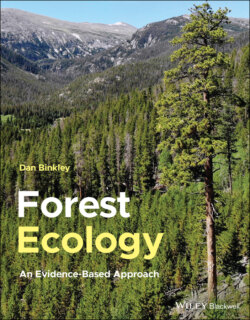Читать книгу Forest Ecology - Dan Binkley - Страница 15
Confidence Bands Around Trends Come in Two Types
ОглавлениеMost of this book's graphs have shaded bands around the trend lines, and these represent the 95% confidence interval around the trend. A narrow band means the value on the Y axis was tightly related to the value on the X axis. Other types of bands can also be used, and Figure D shows a band that describes the distribution pattern for all the observations rather than the confidence warranted in the average trend. Both shaded bands in Figure D deal with 95%, but one describes the region where 95% of the observations are likely to be found, and the other the region where 95% of the trends (from repeated experiments) would be expected to occur. A key point is that the variation in the population of forests does not depend on how many samples are taken; a given proportion of forest would be a bit smaller (or much smaller) than average, and another proportion would be a bit larger (or much larger) than average. That variation does not change as the number of forests are sampled from the same landscape of forests. A sample of 24 forests produces about the same light‐shaded band as a sample of 71 forests, but the confidence warranted in the trend is tighter when based on a larger number of samples (the dark bands).
FIGURE D Rates of wood growth for lodgepole pine forests in Yellowstone National Park, Wyoming, USA rise quickly as new forests develop after fires, and then decline more slowly. The left graph shows that confidence in the average trend is warranted within the dark 95% confidence band. The points are dispersed around that average trend, and the lighter band covers the domain where about 95% of the observations would occur. The graph on the right used only a subset of 24 of the plots, and the average trend is similar, but the smaller number of sampled stands leads to a wider 95% confidence band (the darker band) for the trend compared to the full dataset on the left. The light blue band represents where 95% of the observations would be expected to fall, and the breadth of that band is quite similar between the two sampling intensities
(Source: based on data from Kashian et al. 2013; see also Figure 9.11).
Larger numbers of samples reduce the uncertainty about average trends, but not about the level of variability among forests across a landscape.
